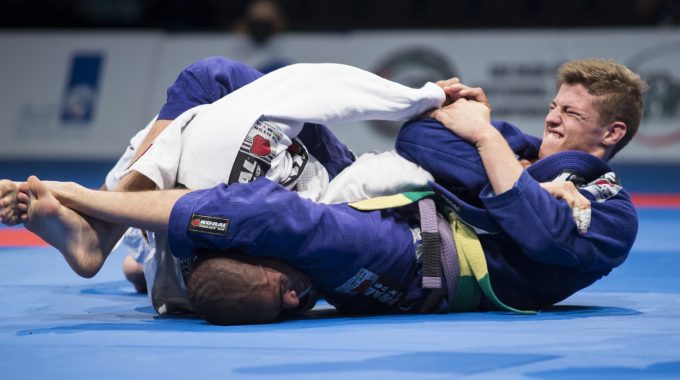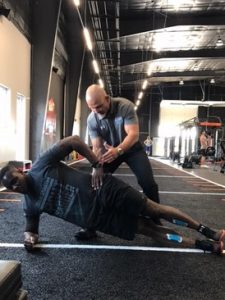
Injury Prevention in Grappling Sports
 As a physical therapists, injury prevention specialist and Brazilian Jiu Jitsu practitioner (5 1/2 years), I am often asked to evaluate fighters, consult with practitioners on rehab with fighters and help design injury prevention programs for clubs or fighters. This has become such a common theme that I am currently in the process of developing a 2 day medical continuing education course on treating the grappling athlete. I see there is a huge need for this kind of information for medical professionals.
As a physical therapists, injury prevention specialist and Brazilian Jiu Jitsu practitioner (5 1/2 years), I am often asked to evaluate fighters, consult with practitioners on rehab with fighters and help design injury prevention programs for clubs or fighters. This has become such a common theme that I am currently in the process of developing a 2 day medical continuing education course on treating the grappling athlete. I see there is a huge need for this kind of information for medical professionals.
For anyone that has been practicing Jiu Jitsu or practices in the grappling sports for a while, you know that orthopedic injuries are a part of the sport. It happens, especially if you roll with new white belts…. (just kidding white belts). For those of us that have been practicing for years, we know the drop out rate, at least in Jiu Jitsu is very high for white belts and for those beginning blue belts. The drop out rate becomes less for purple belts, less yet for brown and black. Why is the rate so high among white and beginning blue belts?
 There are a lot of reasons for this high drop out rate, one of which is orthopedic injuries. This is where I see a huge opportunity for club owners, athletes and clinicians alike. In my role as National Director of Sports Innovation, I work with the largest sports medicine provider in the US (Select Medical) with over 1600 facilities across the US. Our company employs over 900 athletic trainers and provides sports medicine services to over 600 teams (professional, collegiate and high school) and organizations throughout the US. We know sports medicine. We know injury prevention. As such, it is a part of my job to look at injury trends in sports, what innovative things can we do to address those injury trends and how do we deploy strategies to help reduce those trends in that given sport.
There are a lot of reasons for this high drop out rate, one of which is orthopedic injuries. This is where I see a huge opportunity for club owners, athletes and clinicians alike. In my role as National Director of Sports Innovation, I work with the largest sports medicine provider in the US (Select Medical) with over 1600 facilities across the US. Our company employs over 900 athletic trainers and provides sports medicine services to over 600 teams (professional, collegiate and high school) and organizations throughout the US. We know sports medicine. We know injury prevention. As such, it is a part of my job to look at injury trends in sports, what innovative things can we do to address those injury trends and how do we deploy strategies to help reduce those trends in that given sport.
Over the course of the last couple of years, we have been working with several Jiu Jitsu facilities around the US and found there is some simple things that can be done to not only reduce drop out rates, help retain members but also help athletes contend with orthopedic injuries as they arise and keep training through the process. More importantly, help athletes continue to enjoy the lessons and joy that can only come from training on the mat. To effectively reduce injury rates in Jiu Jitsu, it come down to 4 key things that need to be put in place.
- Education
- Injury screens
- BJJ “Friendly” medical providers
- BJJ knowledgeable rehab providers
Over the course of the next several weeks, we will dive into each of these with more depth. However, to start off, I am going to focus on #3 and #4 as this is one of my biggest pet peeves. As a BJJ practitioner and a sports medicine physical therapist with over 20 years clinical experience, it is always frustrating to me when a team mate goes to a physician for a simple injury and the MD tells them to stop training or tells them they need to have surgery for a injury which could be rehabbed and allow them to return without surgery. The biggest problem is that most MDs don’t know exercise (don’t personally do it or have extensive education in), how exercise can be used to effectively treat an injury, let alone a sport like Jiu Jitsu. Personally I think Jiu Jitsu is one of the most physical sports you can do. As a health care provider, you need to understand exercise, the physicality of this sport and the biomechanics of this sport in order to effectively treat athletes participating in.
 As an athlete, we don’t know what the doctor doesn’t know and then take their word as gospel. They should know, they are the doctor. This is a critical aspect for any gym owner or competitive team. You need to get affiliated with a physician that knows BJJ or how to treat combat athletes. Otherwise, when your athletes go to the MD they are most likely going to be told to stop training, scheduled for surgery, be held out for a long time or quite all together. The number of times this happens at an individual gym is astounding.
As an athlete, we don’t know what the doctor doesn’t know and then take their word as gospel. They should know, they are the doctor. This is a critical aspect for any gym owner or competitive team. You need to get affiliated with a physician that knows BJJ or how to treat combat athletes. Otherwise, when your athletes go to the MD they are most likely going to be told to stop training, scheduled for surgery, be held out for a long time or quite all together. The number of times this happens at an individual gym is astounding.
The next cog in the wheel is when the athlete is sent for physical therapy. For the athlete, we trust the doctor in making the referral or maybe someone else we know. This is great if this happens but when it does, it is imperative that the physical therapist understands the sport. I can not begin to tell you how many times I have seen athletes held out far too long or return to the mat without any sort of preparation. For example, if you are being returned to the mat after a knee injury and the first time you are kneeling full weight on your knee to do a knee slide pass is on the mat, then this is a problem. This should have been drills or should have done something similar in rehab. A good sports medicine physical therapist will inquire about your sport, some positions with your sport and provide programming to push ability to do those tasks or positions. We do soccer drills with soccer players, have football players run patterns and do drills with hockey players on the ice and we should be doing it with the Jiu Jitsu athlete.
In addition, your sports medicine physical therapists will have an array of tools available to them to help you get back to the mat. Some of the things that I see that are very effective for the Jiu Jitsu athlete are:
 Dual credentialing – other credentials including, OMT, SCS, OCS, ATC, CSCS to name a few
Dual credentialing – other credentials including, OMT, SCS, OCS, ATC, CSCS to name a few- Dry Needling – technique physical therapists use (where allowed by state law) for the treatment of pain and movement impairments
- Vasopneumatic compression recovery systems – Normatec is very effective in speeding up recovery after a hard training session, especially for lower limbs. Helps reduce muscle soreness and soft tissue injuries.
- Hyperice – they have an area of products used by physical therapists. Two that I use the most are the Vyper and the Hypervolt. These are great to minor strains/sprains and aiding in the recovery process after hard training or competition.
Next week, we will get into injury screens and start to dive into education. Education will be our longest section and is where we will dive into each body part, what are some common injury mechanisms and how do we self treat and prevent. We hope you enjoyed the start of this series. If you did, please share with your colleague and follow us on instagrm @ bjjpt_acl_guy and twitter @acl_prevention. #ViPerformAMI #ACLPlayItSafe